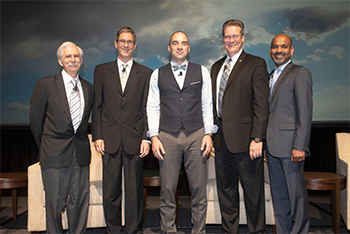Disrupting Aircraft Design and Production Written 25 June 2018
Panelists: Moderator Juan Alonso, professor of aeronautics and astronautics, Stanford University; Rodin Lyasoff, CEO, A^3 by Airbus; Jack O’Banion, vice president of strategy and customer requirements, Advanced Development Programs, Lockheed Martin; Pradeep Fernandes, managing director of disruptive horizons, Boeing HorizonX; Ilan Kroo, Thomas V. Jones professor of engineering, Department of Aeronautics and Astronautics, Stanford University
by Tom Risen, Aerospace America staff reporter (2017-2018)

Companies must rely on new tools for design and development to meet shifting consumer demand with new types of aircraft, including electric vertical takeoff and landing, or eVTOL, vehicles, a group of executives and academics said June 25 during the “New Paradigms in Aviation” panel at the 2018 AIAA AVIATION Forum in Atlanta.
Maturing technologies, including autonomy and increased battery density, give companies opportunity to create “a new layer of transportation” not possible a few years ago, said Pradeep Fernandes, managing director of disruptive horizons at Boeing HorizonX, an arm of Boeing he said exists to “beat our own game.”
The challenge for the aircraft industry, Fernandes said, is to pursue better fuel efficiency, better maintenance costs and lower crew operating costs for a new layer of transportation.
“If you cannot do that, you need a new unique capability that today’s system cannot provide,” he said.
Fernandes cited Boeing’s ecoDemonstrator program — which test flies new technologies, including plant-based biofuel, every year on a commercial airliner — and referred to the eVTOL vehicle being test flown by Aurora Flight Sciences, the Virginia-based company acquired by Boeing last year. Aurora Flight Sciences CEO John Langford is the president of AIAA.
New eVTOL aircraft promise a market for electric flight for commutes from a city to the suburbs by being cleaner and quieter than conventional helicopters, said Rodin Lyasoff, CEO of Silicon Valley-based A^3 by Airbus. The eVTOL aircraft being test flown by A^3 is the Vahana, which will begin test flights to transition from vertical to horizontal flight in August, according to a spokeswoman for the company.
Improvements in automation have made automated assembly lines less costly in car manufacturing factories, Lyasoff said, adding he is curious what can be leveraged from that industry method when eVTOL vehicles such as the Vahana complete the testing and regulation stages and are ready for mass production.
Additive manufacturing is another increasingly mainstream production method that promises lower costs and easier creation of aircraft parts in complex shapes, but “it has to be done with significant care,” said Jack O’Banion, vice president of strategy and customer requirements with Advanced Development Programs at Lockheed Martin, also known as Lockheed Martin Skunk Works.
The challenge for additive manufacturing of aircraft parts is certifying them for safety with regulators, O’Banion said, calling certification “a whole science in itself.”
“It has opened avenues of design that weren’t there before,” O’Banion said of additive manufacturing. “We are able to create new propulsion systems and other things that would have been impossible to machine a part to do.”